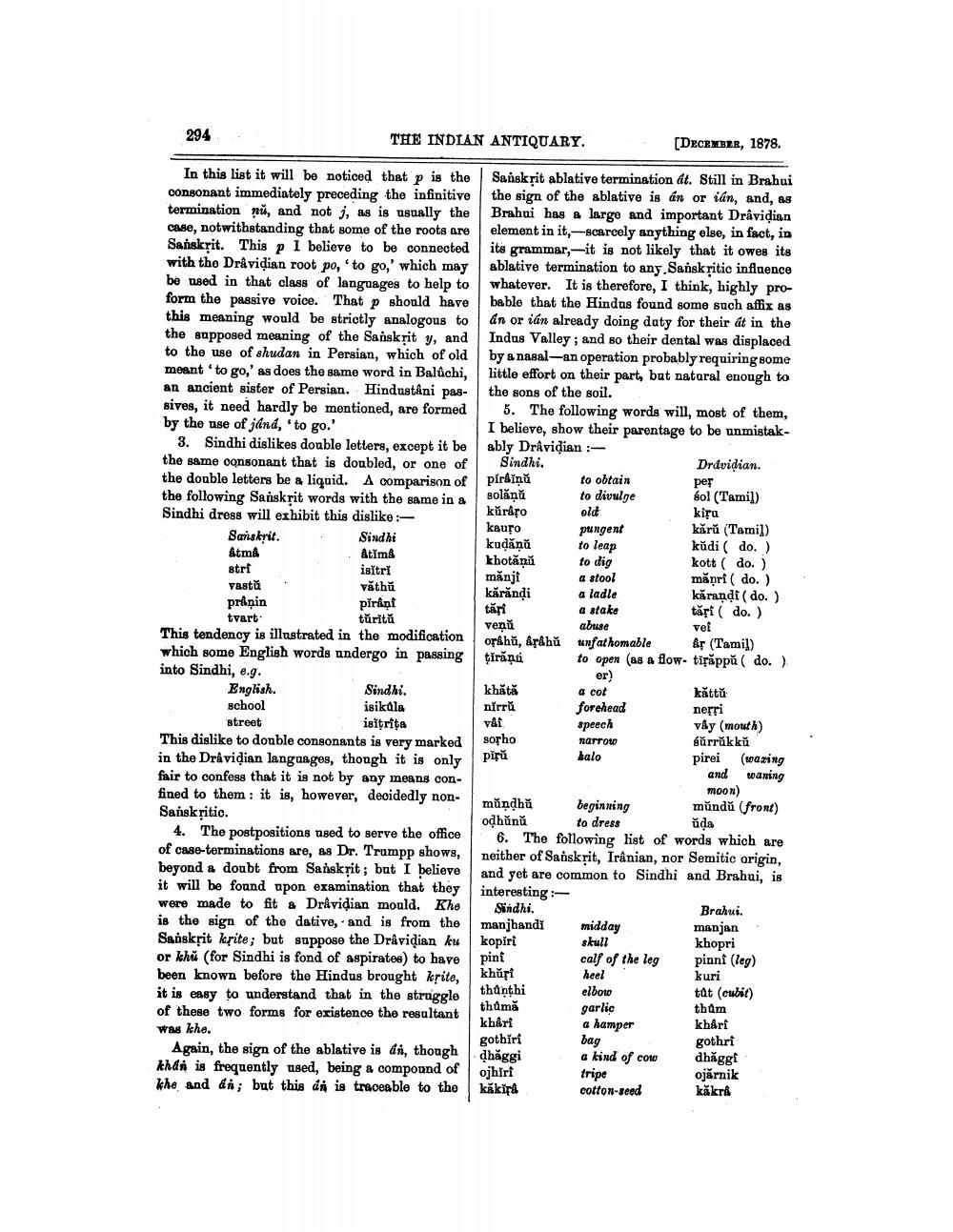________________
294
THE INDIAN ANTIQUARY.
[DECEMBER, 1878.
old
In this list it will be noticed that p is the consonant immediately preceding the infinitive termination rũ, and not j, as is usually the case, notwithstanding that some of the roots are Sanskrit. This p I believe to be connected with the Dravidian root po, 'to go,' which may be used in that class of languages to help to form the passive voice. That p should have this meaning would be strictly analogous to the supposed meaning of the Sanskrit y, and to the use of shudan in Persian, which of old meant to go,' as does the same word in Baluchi, an ancient sister of Persian. Hindustani passives, it need hardly be mentioned, are formed 1 by the use of jánd, 'to go.'
3. Sindhi dislikes double letters, except it be the same consonant that is doubled, or one of the double letters be a liquid. A comparison of the following Sanskrit words with the same in a Sindhi dress will exhibit this dislike : Sanskrit.
Sindhi &tma
Atřmå stri
istri vastă
văthù pråņin
pirani tvart
tutu This tendency is illustrated in the modification which some English words undergo in passing into Sindhi, e.g. English.
Sindhi. school
isikala street
isitrita This dislike to double consonants is very marked in the Dravidian languages, though it is only fair to confess that it is not by any means confined to them: it is, however, decidedly nonSanskritic.
4. The postpositions used to serve the office of case-terminations are, as Dr. Trumpp shows, beyond a doubt from Sanskrit ; but I believe it will be found upon examination that they were made to fit & Dråvidian mould. Khe is the sign of the dative, and is from the Sanskrit krite; but suppose the Dravidian ku or khí (for Sindhi is fond of aspirates) to have been known before the Hindus brought ksite, it is easy to understand that in the struggle of these two forms for existence the resultant Was khe.
Again, the sign of the ablative is di, though khán is frequently used, being a compound of khe and di; but this di is traceable to the
Sanskrit ablative termination dt. Still in Brahui the sign of the ablative is án or ián, and, as Brahui has a large and important Dravidian element in it,-scarcely anything else, in fact, in its grammar,-it is not likely that it owes its ablative termination to any. Sanskritic influence whatever. It is therefore, I think, highly probable that the Hindus found some such affix as an or ián already doing daty for their at in the Indus Valley; and so their dental was displaced by a nasal-an operation probably requiring some little effort on their part, but natural enough to the sons of the soil.
5. The following words will, most of them, I believe, show their parentage to be unmistakably Drávidian :Sindhi.
Dravidian. to obtain
per solăņă to divulge sol (Tamil) kūraso
kira kauso pungent
kără (Tamil) kudănă to leap
kūdi( do.) khoảnh to dig
kott ( do.) mănji a stool
mășri( do.) kărăndi a ladle
kărandi ( do.) tări a stake
tăți ( do. ) venú abruse
vef op&hū, kråhỏ tunfathomable år (Tamil) tirăņu to open as a flow. tirăppă ( do.)
er) khătă a cot
kăttů forehead
nerri vát
vây (mol) sosho narrow
súrrůkků kalo
pirei (waxing
and waring
moon) måndhở beginning mũndă (front) odhữnŭ to dress
ūda 6. The following list of words which are neither of Sanskrit, Irânian, nor Semitic origin, and yet are common to Sindhi and Brahui, is interesting :Sindhi.
Brahui. manjhandi midday
manjan kopiri
khopri pini
calf of the leg pinni (leg) khăți heel
kuri thanthi elbowo
tät (cubit) thumă garlic
tham khari a hamper
khåri bag
gothri dhăggi a kind of coto
dhăggi ojhiri tripe
ojărnik kákira
cotton-seed kákra
nýrrů
speech
рій
skull
gothiri




